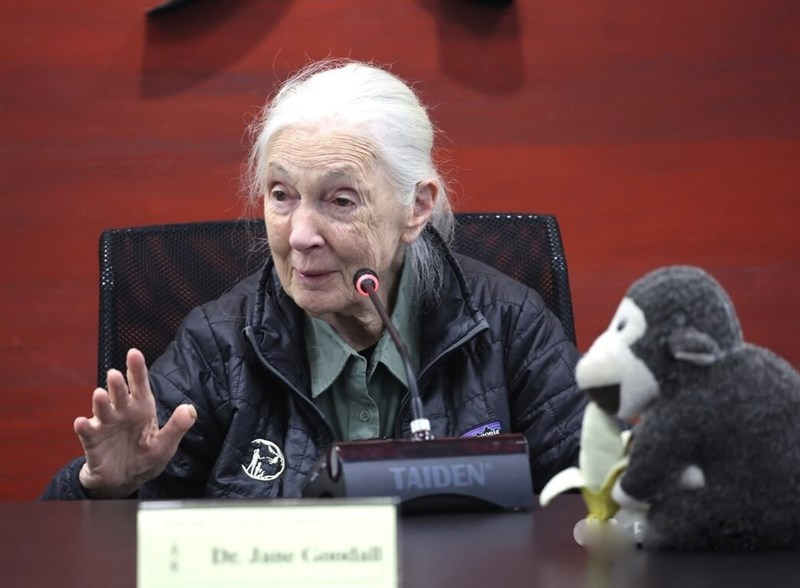World-renowned primatologist and environmental activist Dr. Jane Goodall visited Taiwan for the 18th time, commending the island’s environmental progress over nearly three decades and urging continued efforts toward sustainable human-wildlife coexistence. During her trip, which included meetings with environmental leaders, youth, and government representatives, Goodall praised local conservation efforts and offered globally inspired suggestions to build on Taiwan’s ecological achievements.
A Legacy of Environmental Awareness
When Dr. Goodall first visited Taiwan in 1996, environmental awareness was minimal. “There was very little attention being paid to the environment,” she said in an interview at the Tang Prize Foundation in Taipei. Fast forward to 2025, Goodall sees tangible improvements: cleaner rivers, community coral restoration projects, and youth-led conservation efforts that mirror the global ethos of her institute.
Her comments come amid Taiwan’s continued struggles with rapid urbanization and biodiversity loss—issues she believes the country is tackling with increasing urgency.
Habitat Loss and the Formosan Black Bear: A Warning Sign
One of the critical issues Goodall addressed is the recent rise in human-wildlife conflicts, especially involving the Formosan black bear, an endangered species in Taiwan. These bears have been increasingly seen near human settlements—a sign, she noted, of shrinking natural habitats.
“Because we take their environment away from them,” Goodall emphasized, noting that this phenomenon is not unique to Taiwan but a global crisis.
To resolve these tensions, she recommended the establishment of wildlife corridors—protected strips of habitat that connect fragmented ecosystems. Without such corridors, species face isolation, inbreeding, and eventual extinction. Taiwan’s mountainous terrain and dense urban centers present logistical challenges, but also opportunities for innovative ecological design.
Learning from Global Examples
Goodall pointed to international examples from countries like India, Australia, and the United States, where wildlife corridors have successfully reconnected fragmented habitats. For instance, California’s Liberty Canyon wildlife overpass, currently under construction, will allow mountain lions and other animals to safely cross over highways—a model that Taiwan could adapt for its own species and landscapes.
Her suggestion comes as Taiwan’s Forestry and Nature Conservation Agency has already launched small-scale pilot programs in national parks. Goodall’s endorsement may be the catalyst needed to elevate these initiatives into nationwide strategies.
Investing in the Next Generation: Roots & Shoots
Goodall emphasized that education and youth engagement remain the cornerstone of lasting environmental change. Her youth-led program “Roots & Shoots”, active in 75 countries including Taiwan, empowers students to take action for people, animals, and the environment.
“We’ve been stealing their future for a very long time,” Goodall said, referencing climate inaction and habitat destruction. “We’ve got to help them understand there is a way forward.”
In Taiwan, Roots & Shoots has partnered with schools, municipalities, and NGOs, promoting local conservation projects like urban gardens, wildlife monitoring, and eco-literacy campaigns. These grassroots movements are vital in building a bottom-up environmental culture.
A Call to Action: There’s Still Time
Despite the sobering challenges facing the planet, Goodall remains resolutely hopeful.
“What other options do I have? Do I give up and say it’s hopeless?”
She believes there is still a “window of time” for action, especially with the global scientific community and youth activists becoming more engaged.
During her Taiwan visit, she also met with Tang Prize Foundation Chairman Yin Chung-yao and added her signature to the foundation’s “Table of Honor.” Goodall received the Tang Prize in Sustainable Development in 2020, but had been unable to attend due to COVID-19 travel restrictions.
Taiwan’s Opportunity for Global Environmental Leadership
Jane Goodall’s 2025 visit to Taiwan underscores a broader opportunity for the island nation. With its biodiversity, technological innovation, and civic engagement, Taiwan is uniquely positioned to be a leader in conservation in Asia.
To capitalize on this, experts suggest:
- Scaling up wildlife corridor projects
- Integrating conservation in urban planning
- Expanding community-based conservation programs
- Promoting environmental education in school curricula
As the global climate crisis intensifies, Taiwan’s proactive stance—and continued collaboration with international figures like Goodall—can make it a model for sustainable coexistence.
FAQs
Why did Jane Goodall visit Taiwan?
She visited Taiwan to observe environmental progress, advocate for wildlife conservation, and support local Roots & Shoots programs.
What are wildlife corridors and why are they important?
Wildlife corridors are protected pathways that allow animals to safely move between habitats. They help reduce roadkill, increase genetic diversity, and allow species to adapt to environmental changes.
What is “Roots & Shoots”?
It’s a global youth-led program founded by Goodall to empower young people to take action for people, animals, and the environment.
What species are of concern in Taiwan’s human-wildlife conflict?
The Formosan black bear is a key species. As its habitat diminishes, it’s more frequently seen near human areas, raising concerns for both safety and conservation.
What is the Tang Prize?
Established in 2012, the Tang Prize honors significant achievements in sustainable development, biopharmaceutical science, sinology, and the rule of law.


